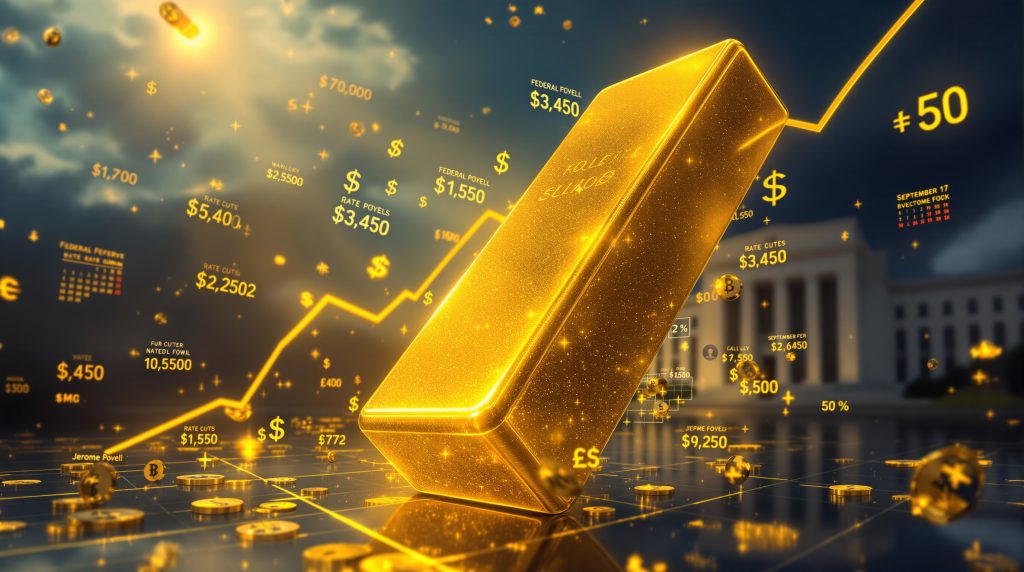Gold Surges Toward $3,450: What's Driving the Rally and What's Next?
Gold prices have climbed impressively in recent weeks, reaching near $3,450 per ounce as investors increasingly bet on Federal Reserve interest rate cuts. This rally represents a significant milestone in gold's upward trajectory, with prices gaining momentum from multiple economic catalysts. The current gold price forecast 2025 suggests this trend could continue.
The Fed's Dovish Pivot
The Federal Reserve's shifting stance toward monetary easing has become the primary driver behind gold's recent surge. Following Jerome Powell's Jackson Hole address, markets have interpreted his comments as opening the door wide for a September rate cut. This sentiment has strengthened as economic data continues to provide justification for the Fed to begin lowering rates.
Current market pricing indicates:
- 88-90% probability of a 25-basis-point cut at the September 17th meeting
- Growing expectations for multiple cuts through year-end
- Increased confidence that the Fed's tightening cycle has conclusively ended
Economic Data Supporting Rate Cut Narrative
Recent economic indicators have aligned perfectly to support the case for monetary easing:
| Economic Indicator | Recent Reading | Impact on Gold |
|---|---|---|
| Q2 GDP (Revised) | +3.3% QoQ | Positive – Shows economy can withstand rate cuts |
| PCE Price Index | Neutral | Positive – Inflation not accelerating |
| Labor Market Data | Moderating | Positive – Suggests cooling economy |
Thursday's better-than-expected GDP revision to 3.3% quarter-over-quarter provided a surprising catalyst for gold. Rather than pressuring prices downward (as strong economic data sometimes does), it reinforced the narrative that the economy remains resilient enough for the Fed to safely begin cutting rates without risking a hard landing.
Why Does Gold Benefit From Interest Rate Cuts?
The relationship between gold prices and interest rates forms the foundation of the current rally. Understanding this connection helps explain why traders are aggressively buying gold in anticipation of Fed easing.
Non-Yielding Asset Dynamics
Gold traditionally faces headwinds during periods of rising interest rates and high yields because:
-
As a non-yielding asset, gold becomes less attractive when interest-bearing investments offer higher returns
-
Higher rates typically strengthen the US dollar, making gold more expensive in other currencies
-
The opportunity cost of holding gold increases when yields on bonds and other fixed-income assets rise
The reverse occurs when rates fall:
-
Lower yields reduce gold's opportunity cost
-
Dollar weakness makes gold more affordable globally
-
Investors seek alternative stores of value as real returns on cash diminish
Historical Performance During Rate Cut Cycles
Gold has historically performed well during Fed easing cycles. Analysis of previous rate-cutting periods shows gold averaging double-digit percentage gains in the 12 months following the first cut of a cycle. Recent all-time high analysis confirms this pattern is holding true.
What Technical Factors Are Supporting Gold's Rise?
Beyond fundamental economic drivers, technical factors have contributed to gold's momentum toward $3,450.
Price Action and Technical Indicators
Gold's price chart reveals several bullish technical developments:
-
Break above previous resistance at $3,375
-
Positive momentum indicators showing strong buying pressure
-
Limited pullbacks suggesting strong underlying support
-
Upward-sloping moving averages confirming the bullish trend
Market Positioning and Sentiment
Institutional positioning in gold futures and options markets shows:
-
Hedge funds increasing long positions
-
Commercial traders (typically hedgers) maintaining relatively balanced exposure
-
Retail investment demand rising through ETFs and physical purchases
This combination of positioning suggests a healthy market structure without excessive speculative froth that might signal an imminent reversal. According to recent analysis from FX Street, mounting global risks are further supporting gold's price trajectory.
How Are Global Uncertainties Affecting Gold Demand?
While monetary policy expectations dominate the current narrative, ongoing global uncertainties continue providing additional support for gold prices.
Geopolitical Tensions
Several geopolitical factors contribute to gold's appeal as a safe-haven asset:
-
Ongoing conflicts in multiple regions
-
Trade tensions between major economies
-
Political uncertainties in key markets
-
Resource nationalism affecting mining jurisdictions
These factors create a persistent baseline of demand for gold as a crisis hedge, regardless of interest rate expectations. The expectation of a historic 3000 price surge is partly based on these geopolitical considerations.
Central Bank Buying Trends
Central banks globally have maintained their gold purchasing programs:
-
Emerging market central banks diversifying reserves away from dollars
-
Developed market central banks maintaining or slightly increasing gold allocations
-
Net central bank buying continuing to absorb significant physical supply
This official sector demand provides a strong floor under prices and signals long-term confidence in gold's role in the global financial system.
What Could Derail Gold's Rally?
Despite the bullish sentiment, several factors could potentially interrupt gold's climb toward higher levels.
Potential Headwinds
The most significant near-term risks include:
-
Stronger-than-expected jobs data: Next week's August employment report could show unexpected strength, reducing rate cut expectations
-
Hawkish Fed communications: FOMC members might push back against market expectations of multiple cuts
-
Profit-taking: After such a strong run, short-term traders might lock in gains
-
Technical resistance: Previous all-time highs often serve as psychological barriers
Market Sensitivity to Data Surprises
Gold prices have become increasingly sensitive to economic data surprises as the September FOMC meeting approaches. This heightened sensitivity creates the potential for volatility in both directions based on incoming data.
What Are Gold Price Forecasts for Late 2025?
Looking ahead, analysts have adjusted their gold price targets upward in response to the recent rally and changing monetary policy outlook.
Year-End Projections
Current forecasts for gold prices by year-end include:
-
Conservative estimates: $3,500-$3,550
-
Median projections: $3,600-$3,650
-
Bullish outlooks: $3,700-$3,750
These projections assume at least two 25-basis-point rate cuts and continued central bank buying. As reported by Economic Times, some analysts are even targeting $3,700 in their projections.
Long-Term Outlook
Beyond the immediate horizon, structural factors supporting higher gold prices include:
-
Persistent global debt levels
-
Potential for higher long-term inflation
-
Ongoing de-dollarization trends
-
Supply constraints from maturing gold mines
How Should Investors Approach Gold at Current Levels?
With gold trading near all-time highs, investors face important considerations regarding portfolio allocation and entry points.
Portfolio Considerations
Financial advisors typically suggest:
-
Maintaining gold allocations of 5-10% in diversified portfolios
-
Viewing gold as a portfolio diversifier rather than a speculative trade
-
Considering dollar-cost averaging for new positions rather than lump-sum investing at record prices
Entry Strategy Options
For those looking to establish or add to gold positions, strategic approaches include:
-
Partial allocation: Deploying only a portion of intended capital at current levels
-
Technical entry points: Waiting for pullbacks to identified support levels
-
Derivatives strategies: Using options to establish positions with defined risk parameters
Understanding gold price impact on equities can also help investors make more informed decisions about their overall portfolio.
What's Next for Gold: Jobs Report as the Critical Catalyst
The immediate future for gold prices likely hinges on next week's August Jobs Report, scheduled for release on Friday.
Employment Data Significance
This report carries outsized importance because:
-
It represents the last major employment data before the September FOMC meeting
-
Labor market conditions have become central to the Fed's decision-making process
-
Recent employment trends have shown signs of cooling, supporting the case for cuts
Potential Market Reactions
Possible scenarios include:
| Jobs Report Outcome | Likely Gold Price Reaction |
|---|---|
| Much Weaker Than Expected | Strong rally toward $3,500+ |
| Slightly Weaker Than Expected | Moderate gains, testing $3,475 |
| In-line With Expectations | Consolidation near current levels |
| Stronger Than Expected | Pullback toward $3,375-$3,400 |
| Much Stronger Than Expected | Sharp correction below $3,350 |
FAQ: Gold's Rally and Rate Cut Expectations
Why is gold rallying when the economy still shows strength?
Gold is rallying because markets are forward-looking, focusing on the Fed's likely policy path rather than current economic conditions. The anticipated shift to rate cuts benefits gold even if the economy remains relatively healthy.
How much further could gold prices rise if the Fed cuts rates in September?
If the Fed delivers a 25-basis-point cut in September, gold could potentially test the $3,500-$3,550 range, especially if the accompanying statement suggests more cuts ahead. A 50-basis-point cut, though unlikely, could push prices toward $3,600.
What happens to gold if the Fed doesn't cut rates in September?
A Fed decision to hold rates steady in September would likely trigger a significant pullback in gold prices, potentially toward the $3,250-$3,300 range, as markets would need to reprice expectations for the entire rate cut cycle.
Is physical gold or gold ETFs better for investing in the current environment?
Both physical gold and ETFs offer exposure to gold prices, but with different characteristics:
- Physical gold provides direct ownership without counterparty risk but involves storage costs and potential premiums
- Gold ETFs offer convenience and liquidity but come with management fees and depend on financial market infrastructure
The better choice depends on individual investment goals, time horizon, and risk preferences. Current gold market performance metrics may also influence this decision.
How does gold's performance compare to other precious metals in this environment?
Gold has outperformed silver, platinum, and palladium, benefiting from its stronger monetary characteristics during periods of expected rate cuts. Silver typically follows gold's direction but with higher volatility, while platinum and palladium respond more to industrial demand factors.
Further Exploration
Readers interested in learning more about gold price trends and Federal Reserve policy can also explore related educational content at GoldPrice.org, which offers various perspectives on precious metals markets and monetary policy developments.
Want to Spot the Next Major Mineral Discovery?
Stay ahead of the market with Discovery Alert's proprietary Discovery IQ model, which instantly identifies significant ASX mineral discoveries and transforms complex data into actionable investment insights. Explore why major mineral discoveries can lead to substantial returns by visiting Discovery Alert's dedicated discoveries page and begin your 30-day free trial today.




